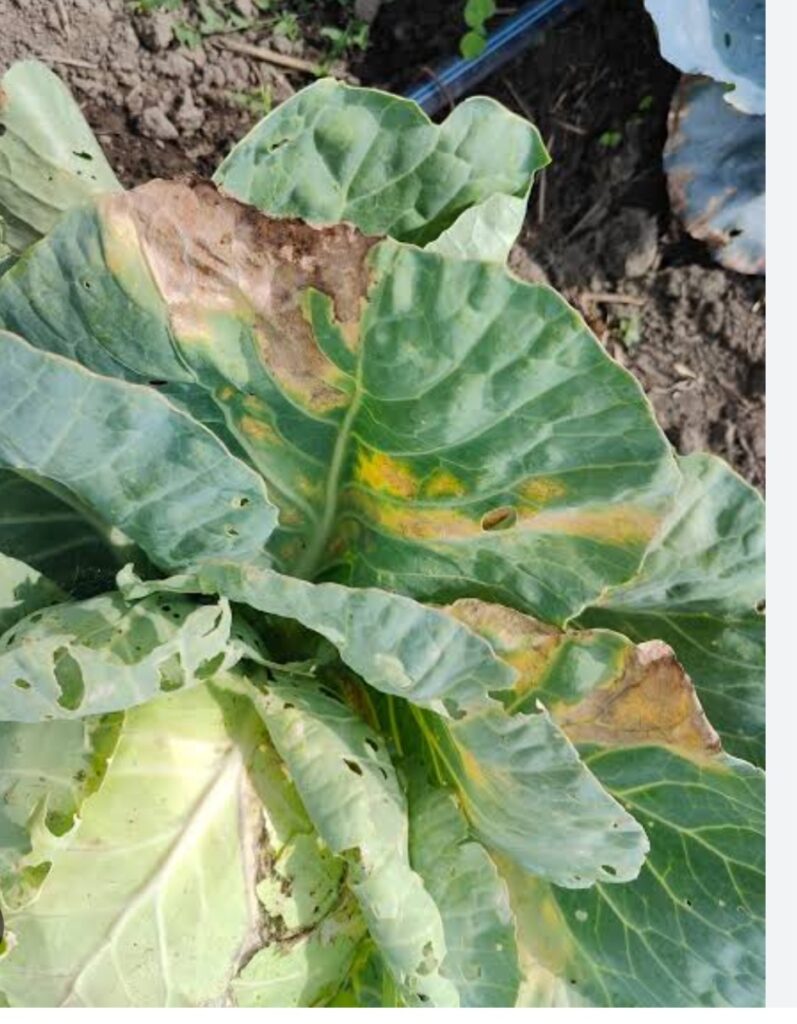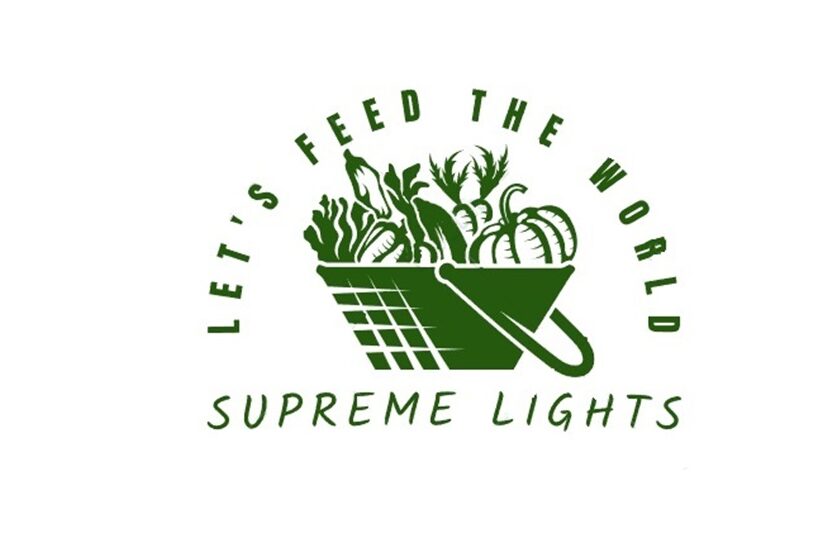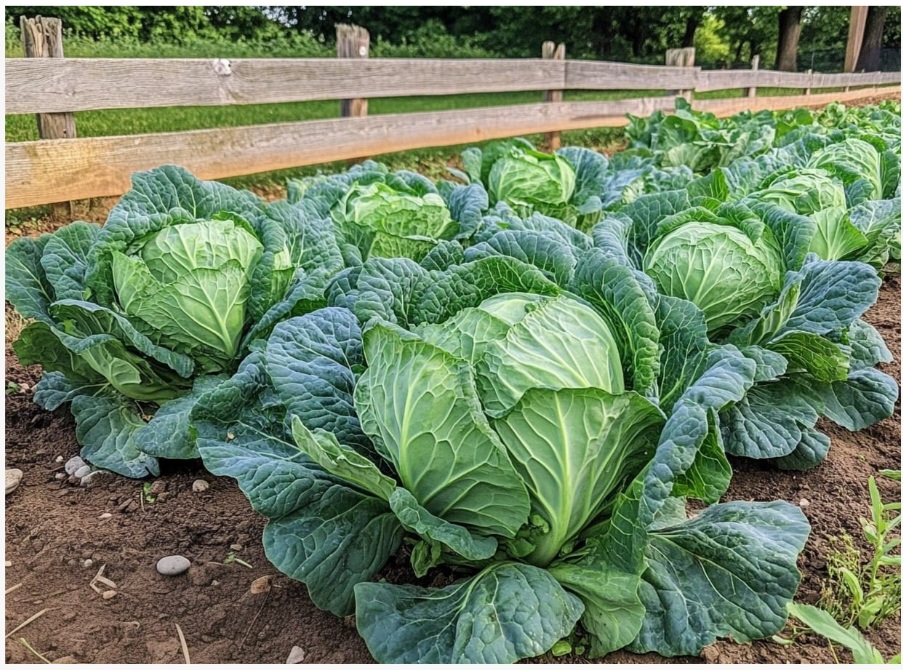
Cabbage (Brassica oleracea var. capitata), belongs to the brassica family (also called cruciferae family) or mustard family (Brassicaceae). It is a leafy green vegetable and a fodder plant that comes in a variety of colours such as: green, white, purple and red. It is a biennial plant grown as an annual vegetable crop for its dense-leaved heads. It descend from the wild cabbage (B. oleracea var. oleracea), a member of the “cole crops” or brassicas, meaning it is closely related to broccoli and cauliflower (var. botrytis); Brussels sprouts (var. gemmifera); radishes; and Savoy cabbage (var. sabauda).
Cabbage, been grown around the world for thousands of years is a common ingredient in many dishes, such as salad, kimchi and sauerkraut. It has a long history of medicinal use. Different references had stated its uses for the prevention of drunkenness, headache, stomach ailments, and even cancer.
DESCRIPTION OF CABBAGE
Cabbage is a dense, leafy vegetable. While it looks similar to a head of lettuce, it’s actually a member of the “cruciferous” vegetable group that includes broccoli, kale, radishes, Brussel sprouts, and more.
All cabbages have heads formed from tightly packed leaves. There are many distinct head types, the most common being: Wakefield (with small, early, white, pointed heads; for fresh market), Red (leaf surfaces are pigmented, medium very firm, round heads; for fresh market and storage); Ballhead or Danish (round, very firm heads, light green leaves; for fresh market and storage); Savoy (some authorities designate this Brassica oleracea var. sabauda) (round, loose heads with crinkled or blistered leaves; for fresh market and storage).
Its leaves can be either crinkled or smooth.
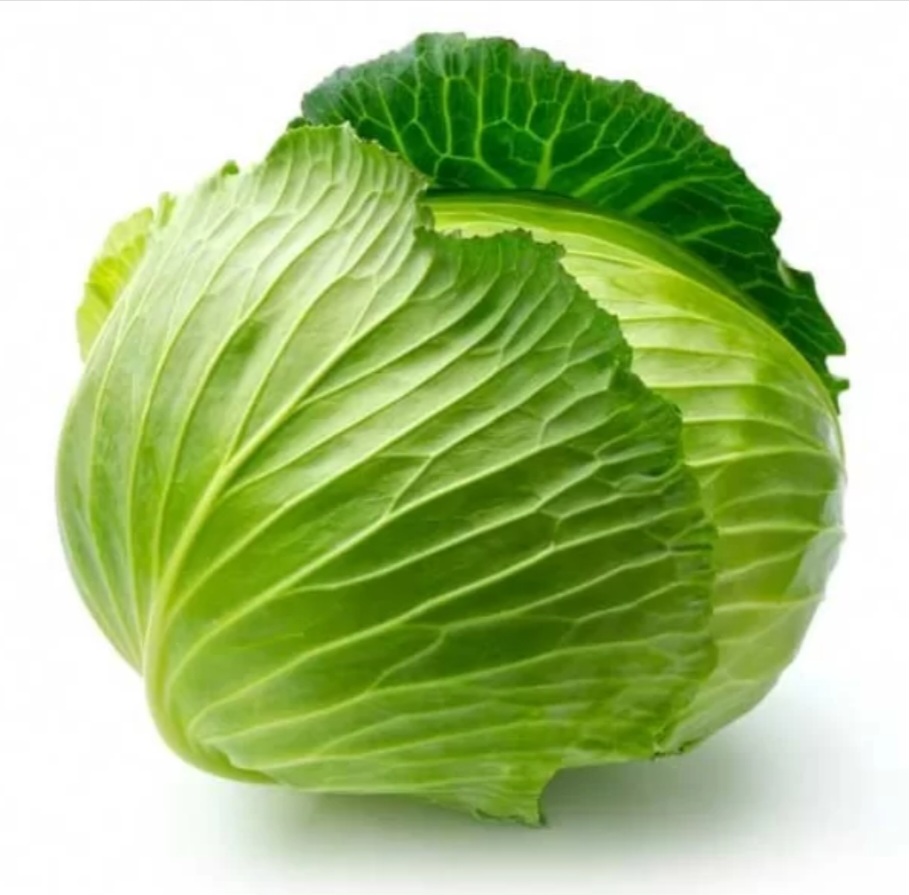
BENEFITS OF CABBAGE
Cabbage, like other cruciferous vegetables, is packed with a lot of benefits.
1. It is rich in vitamins and minerals that the human body needs. It is packed with;
Vitamin K: 56% of Daily Value (DV)
Vitamin C: 36% DV
Folate (B9): 10% DV
Manganese: 6%
Vitamin B6: 6% DV
Thiamin (B1): 5% DV
Pantothenic Acid (B5): 4% DV
Calcium: 3% DV
Magnesium: 3% DV
Potassium: 3% DV
Riboflavin (B2): 3% DV
Vitamin A (IU): 3% DV
2. It is low in calories.
3. It is often referred to as a superfood due to its impressive nutritional content. One cup of cabbage contains:
Calories: 22
Total fat: 0.1 g
Cholesterol: 0 mg
Sodium: 16 mg
Total carbs: 5.2 g
Dietary fiber: 2.2 g
Sugar: 2.8 g
Added sugar: 0 g
Protein: 1.1 g
Apart from these, it also contain salt, and sugar, some fiber and protein as well.
4. IMPROVED DIGESTION: Foods that contain fiber are an important part of a balanced diet and support a healthy digestive system. The fiber found in cabbage can help improve the digestive system and promote regular bowel movements.
In addition, the soluble fiber in cabbage has been shown to increase the number of beneficial bacteria in the gut. This is because fiber is the main fuel source for friendly species like Bifidobacteria and Lactobacilli. These bacteria perform important functions like protecting the immune system and producing critical nutrients like vitamins K2 and B12
5. Its protein is considered a healthy alternative to protein from meats.
6. CABBAGE IS A GREAT SOURCE OF ANTIOXIDANTS : These compounds help the body fight against free radicals- compounds that can damage the cells. Free radicals are thought to contribute to the development of diseases such as cancer, heart disease, and diabetes.
Antioxidants help reduce the free radicals in human body and help improve the immune system and fight inflammation that can be damaging to the human body.
7. REDUCED INFLAMMATION: Inflammation is the way the body helps fight infection or speed up healing. However, chronic inflammation is thought to contribute to conditions such as heart disease, stroke, cancer, rheumatoid arthritis, and inflammatory bowel disease. The antioxidants in cabbage help reduce inflammation, which is linked to heart disease and also diseases linked to chronic inflammation. Cabbage also contains a substance called anthocyanins. It contains more than 36 different kinds of potent anthocyanins, making it an excellent choice for heart health.
Several studies have found these compounds as a substance that can lower blood pressure and reduce the risk of heart attack and stroke.
A research carried out in 2013 on 93,600 females, the findings prove that those with a higher intake of anthocyanin-rich foods had a lower risk of a heart attack. This had also been supported by another analysis involving 15 observational studies. The study reported that increased intake of flavonoids was associated with a significantly lower risk of dying from heart disease.
Finally, while too much sodium in the diet is linked to heart disease, the potassium in cabbage helps the body get rid of excess sodium through the urine.
It is believed that the sulforaphane, kaempferol, and other antioxidants found in this cabbage plants are likely responsible for their anti-inflammatory effect.
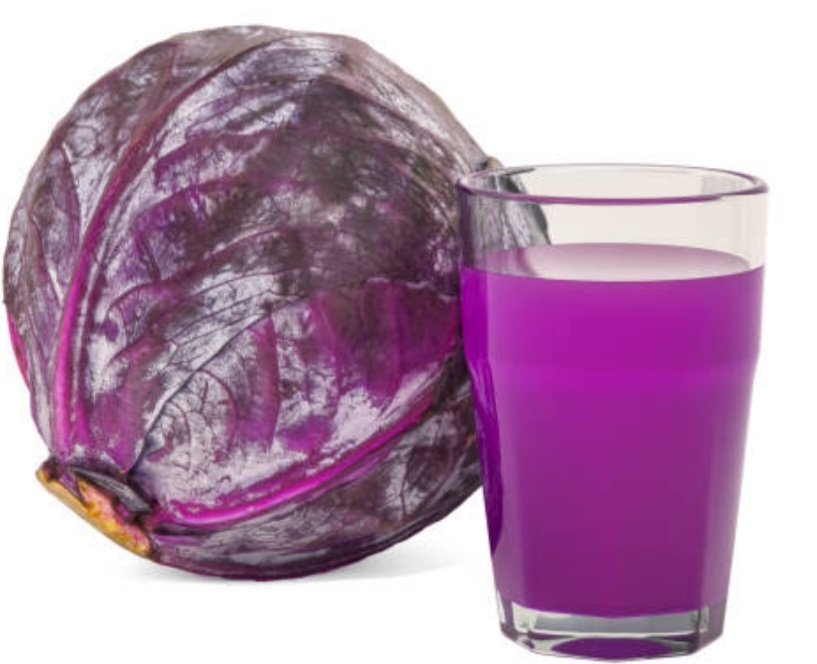
8. IMPROVED IMMUNE SYSTEM: The vitamin C found in cabbage is good for the body. Not only is it an antioxidant that fights free radicals, but it also helps to fight heart disease, cancer, and even common cold. Vitamin C also helps the body to absorb the iron it needs.
9. STRONGER BONES: Cabbage is loaded with vitamin K. This important vitamin helps the body fight the breakdown of bone and improves bone strength. It is believed that a lack of vitamin K can contribute to the development of osteoporosis and an increased risk of fractures, especially in older individuals.
10. MANAGING DIABETES: Because cabbage is low in carbohydrates and high in fiber, it’s a great choice for those living with diabetes as it can help keep blood sugar levels stable without dangerous spikes.
11. Cabbage leaves have long been used as poultices for application to tumors, and even in modern times, they have been under investigation as a means for preventing or treating breast engorgement in nursing mothers.
12. Cabbage is can be eaten fresh, processed into a salad-like dish called coleslaw, boiled, or as a fermented and pickled product called sauerkraut. Cabbages are important as a fresh market crop as well as a processing crop in most parts of the world and rank in the top 10 vegetables in both sales and volume in North America and Europe.
13. Cabbage has very firm and small heads used for canning.
14. Cabbage also contains small amounts of other micronutrients, including vitamin A, iron, and riboflavin .
15. It is rich in vitamin B6 and folate, both of which are essential for many important processes in the body, including energy metabolism and the normal functioning of the nervous system.
16. In addition, cabbage is high in fiber and contains powerful antioxidants, including polyphenols and sulfur compounds .
17. CABBAGE IS PACKED WITH VITAMIN C: Vitamin C ( ascorbic acid), is a water-soluble vitamin that serves many important roles in the body.
It is needed to make collagen, a protein in the human body. Collagen gives structure and flexibility to the skin and is critical for the proper functioning of the bones, muscles, and blood vessels.
Also, vitamin C helps the body absorb non-heme iron majorly found in plant foods.
18. LOWER CHOLESTEROL LEVELS:
Cholesterol is a waxy, fat-like substance found in every cell in human body. People with high cholesterol level tend to have an increased risk of heart disease, especially when they have elevated levels of LDL (bad) cholesterol.
Cabbage contains two substances that have been shown to decrease levels of LDL (bad) cholesterol ( soluble fiber and plant sterols) .
Soluble fiber can help lower LDL cholesterol levels by binding with cholesterol in the gut and keeping it from being absorbed into the blood.
In a reseach carried out in 2023. The meta-analysis showed a significant reduction in LDL and total cholesterol with soluble fiber supplementation. Cabbage is a good source of soluble fiber. About 40% of the fiber found in cabbage is soluble.
Plant sterols also called phytosterols are substances in plants that are structurally similar to cholesterol, and they reduce LDL cholesterol by blocking the absorption of cholesterol in the digestive tract.
A research carried out in 2020 by the American Heart Association reveals that 2-3 grams of plant stanol esters a day reduced LDL cholesterol by 9-12%.
19. AN EXCELLENT SOURCE OF VITAMIN K: Vitamin K is a fat-soluble vitamins that plays many important roles in the body, one of which is blood clotting.
There are two types of vitamins K: Vitamin K1 and K2.
Vitamin K1 (phylloquinone): This is found primarily in plant. While,
Vitamin K2 (menaquinone): This form is found in animals and some fermented foods. It is also produced by bacteria in the large intestine.
Vitamin K1 plays many important roles in the body. Such roles include; It act as a cofactor for enzymes that are responsible for clotting the blood.
Without vitamin K, the blood would lose its ability to clot properly, increasing the risk of excessive bleeding.
20. CABBAGE JUICE: Cabbage can be processed into juice. The juice is loaded with nutrients, such as vitamins C and K, and drinking it is linked to many purported benefits, including weight loss, improved gut health, decreased inflammation, balanced hormones, and body detoxification. It is also high in antioxidants etc. It performs all the benefits listed above except that it is a juice. Apart from the above, the juice also reduced risk of lymphoma in women.
21. Cabbage contains beta carotene, a precursor to vitamin A. Studies show drinking its juice results in better absorption of beta carotene, compared with eating whole cabbage
THE NEGATIVE SIDE OF CABBAGE
While cabbage offers lots of health benefits from the vitamins, minerals and compunds found in it, It also have some downside to eating it.
1. Cruciferous vegetables like cabbage can cause gas, bloating and diarrhea. It’s best to slowly introduce these vegetables into the diet and gradually increase it’s intake. Individuals with sensitive digestive tracts might want to limit cabbage or talk to their doctor.
2. If placed on a blood thinner such as Warfarin, patients should discuss with their doctor before increasing their intake of cabbage. The vitamin K in cabbage can interfere with the effectiveness of blood thinning medications.
3. HIGH AMOUNTS MAY AFFECT THE THYROID:
Some evidence suggests that consuming cabbage in high amounts may affect thyroid. Substances called goitrogens in cabbage can inhibit iodine transport to the thyroid, a process necessary for normal thyroid function.
In additon, goitrogens are found in higher amounts in raw cabbage, so those with thyroid conditions, such as hypothyroidism, may choose to avoid consuming cabbage juice.
4. CERTAIN NUTRIENTS CAN INTERACT WITH MEDICATIONS:
Some nutrients in cabbage juice have been shown to interact with certain medications. Cabbage is rich in vitamin K, which can affect the ability of blood thinners like warfarin to prevent blood clots. It is typically advised to maintain a consistent vitamin K intake while on the medication.
5. JUICING CABBAGE LEAVES MUCH OF THE FIBER BEHIND:
Juicing vegetables removes much of their fiber content. Fiber promotes feelings of fullness, maintain gut health, helps stabilize blood sugar, and can reduce cholesterol level. Due to the high fiber content, cruciferous vegetables like cabbage have been acknowledged for their ability to positively alter gut bacteria.
However, by juicing cabbage rather than eating it raw, this may reduce much of its fiber content.
6. MAY CAUSE ABDOMINAL DISCOMFORT IN SOME PEOPLE:
Some individuals may experience gut discomfort from drinking cabbage juice.
Cabbage is a common gas-producing vegetable. It is also high in fructans, a type of carb that individuals with irritable bowel syndrome (IBS) often have, causing difficulty in time of digestion. Even with low intakes of cabbage, people with IBS may experience symptoms, such as bloating, abdominal pain, and diarrhea.
CABBAGE AS LIVESTOCK FEED
Cabbage can also be fed to livestock, such as cattle, pigs, rabbits, goats, and sheep. It is a nutritious, easily digestible crop that can help reduce animal feeding costs. In addition, cabbage improves growth performance, improves carcass characteristics, improves pig health, can help manage diseases like white mold and black rot, and can help reduce environmental impact.
In a research study to determine the the effect of cabbage leaves as roughages on growth performance and bood biochemical parameters of rabbits, the study proved that cabbage leaves can be fed to growing rabbits as roughage source without any adverse effects on growth performance and blood biochemical parameters.
However, cabbage also has adverse negative effect on some livestock when fed to them. It can cause digestive issues and poisoning if not fed properly.
RISKS FACTORS OF FEEDING CABBAGE TO LIVESTOCK
1. Can cause digestive issues
2. Can cause poisoning
3. Can cause bloating and gaseousness in sheep, which can be fatal
4. In cattle, it can cause rumen acidosis due to its high sugar content, haemolytic anaemia and goiter in livestock due to the high amino acid compund in the cabbage.
5. When lamb feed on immature cabbage leaves, a condition called photosensitisation results. This disorder is costly to treat and in acute condition, it leads to death.
6. Cabbage contains a component called glucosinolate. When fed to dairy cow, the component taints the milk produced. Therefore, to feed cabbage to livestock, the following must be ensured or carried out:
1. MONITOR THE ANIMALS: Watch the animals for adverse reactions that can cause health issues like bloat, pneumonia and nitrate poisoning.
2. INTRODUCE CABBAGE SLOWLY: Allow animals to graze in small amounts at first and if they are found reacting to the vegetable, withdraw immediately. Feeding ruminants slowly with cabbage will allow the rumen microbes adjust slowly to the roughage.
3. LIMIT DAIRY COWS: Lactating dairy cows should only eat about 30% cabbage forage.
7. MANAGE SULFUR: Cabbage waste is high in sulfur, so do not feed it to animals that already eat other high sulfur foods.
8. FEED IN SMALL AMOUNTS: Feed cabbage waste in small amounts over a few days to prevent leachate. Excess feeding will make the animals reduce intake because of the high moisture content in the vegetable.
9. STORE PROPERLY: Cabbage are highly perishable vegetables. Therefore, their waste should be stored in a bunker silo where leachate can be collected.
10. CABBAGE -FORAGE MIXTURE : It should be mixed with chopped hay or forages straws to limit seepage problems.
11. It should be wilted in the sun especially when fed to rabbits to prevent bloat.
12. Suppliment the cabbage with iodine, copper and iron to meet the dietary requirements and to prevent rumen acidosis, haemolytic anaemia and goiter in cattle. etc.
FORMS, TYPES OR VARIETIES OF CABBAGE
The different forms of cabbage include wild cabbage, brussels sprouts, cauliflower, broccoli, head cabbage, kale, and kohlrabi.
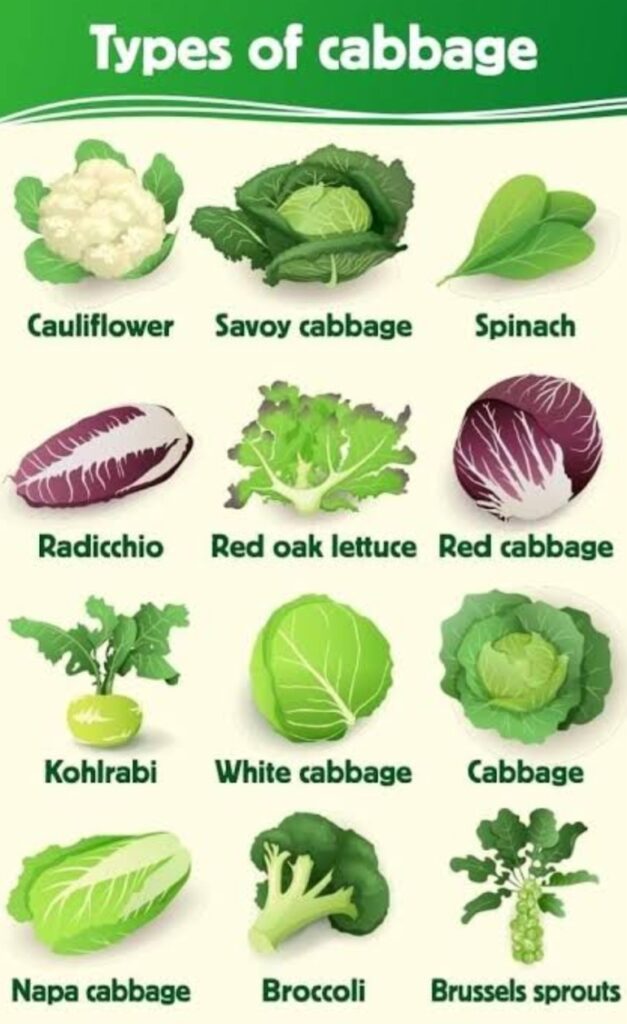
All forms of cabbage have succulent leaves that are free of hairs and covered with a waxy coating, which often gives the leaf surface a gray-green or blue-green colour. The common forms of cabbage may be classified according to the plant parts used for food and the structure or arrangement of their parts.
Some of the varieties of cabbage available in different parts of the world include:
Green cabbage, red cabbage, savoy cabbage, dutch white cabbage, conehead cabbage, kohlrabi, tuscan cabbage, january king cabbage, portuguese cabbage, brussels sprouts, earliana cabbage, golden acre cabbage, red acre cabbage and Chinese cabbages which include; bok choy (Brassica rapa, variety chinensis) and napa cabbage (B. rapa, variety pekinensis) etc.

CABBAGE CULTIVATION REQUIREMENT
CLIMATIC REQUIREMENT
Cabbage is a cool season crop which requires an optimum growth temperatures range of 15- 20°C. Head formation reduced at temperatures higher than 25°C. It requires adequate amount of rainfall to growth. Moisture levels are especially critical during the early stage of the vegetables growth. If the levels are low, irrigation should be used to supplement and relieve the moisture stress.
SOIL TYPE
Not all soils are suitable for cabbage production. Clay soils or dark cotton soils are poorest for cabbage production. Soils with poor drainage, crack when dry, and flood when wet are poor for cabbage production. The best soil is loamy fertile soil, rich in organic matter, or sandy loam or loam which are well drained and with water retension capacity. Such soils have ability to supply water and nutrients to the cabbage.
Cabbage can thrive in soils with pH levels between 6.0-6.5.
Soil analysis are recommended for planting and accurate fertilization.
CHOOSING A VARIETY
While making a choice on the variety to produce, a farmer need to consider several key factors among the varieties. Such factors considered include: the maturity duration, yield potential, tolerance and resistance to pests and diseases, good field holding capacity, uniform maturity to ensure a single harvest and preference in the market among other qualities.
1. The variety must have wide market acceptability to others.
2. Must have the shortest maturity period ( 90 days).
3. Must have uniform maturity on farm. Not that some are big in size at harvest and others small in size. This will not make buyers to appreciate their non uniform size at harvest.
4. They must have good weight or maturity ( atleast 4kg at harvest).
5. They must be tolerant to hot and cold weather.
6. They must have good resistant to diseases especially black rot disease.
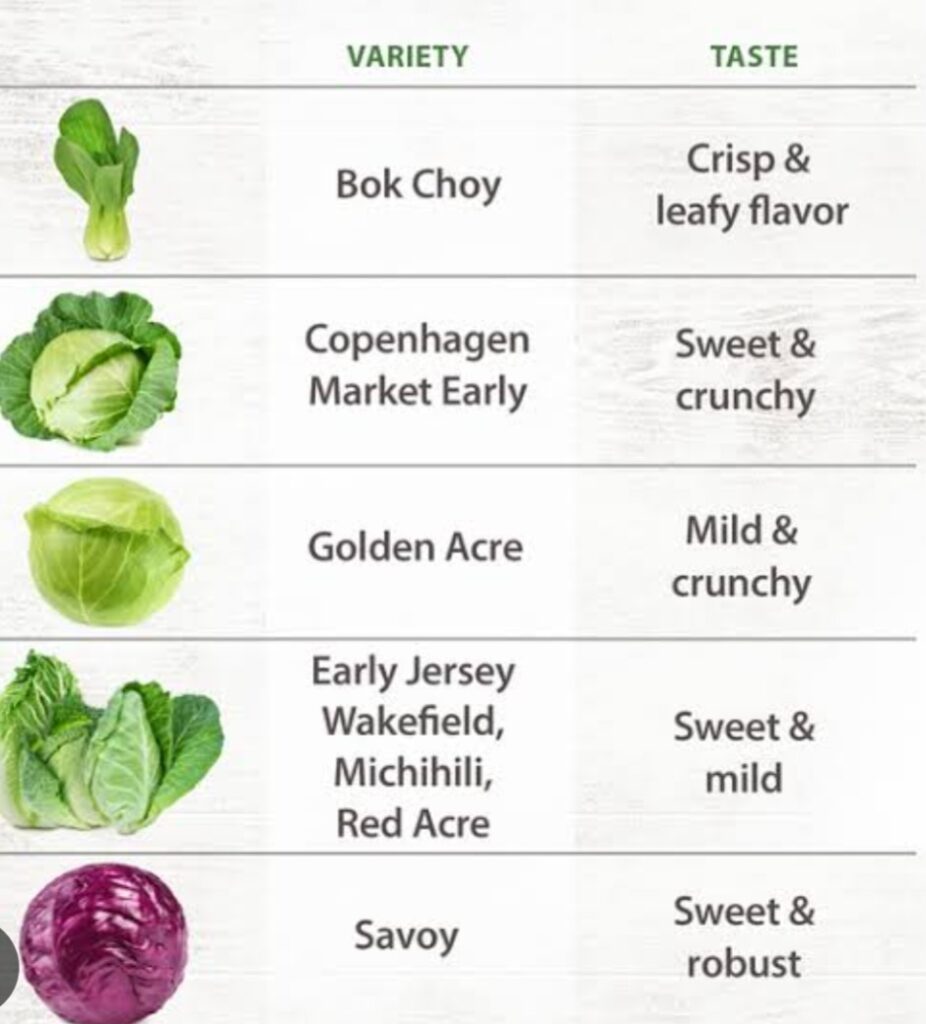
All cabbage varieties vary in size, weight, maturity period, colour and weather tolerant etc.
PLANTING
The best time to plant cabbage in the tropics is when the market supply is high such that harvesting coincides with the driest months. For example, if in 2 months time there will be complete dryness, then cabbage can be planted.
In dry months, vegetables are usually scarce, vegetable consumers only rely on dry season production. During this period, the demand for cabbage are usually high. When the demand is high, the price will also be high. If cabbage are planted in such that they coincide with rainy months, there will be glot and plenty of other vegetables in the market. Thus, reducing the demand and price.
Also, cabbage can be planted 2 months after the high price. For example, if prices are high in the month of January, cabbage can be planted 2 months after. Cabbage produced during this time attract high price especially when there is heavy rain that destroys vegetables. This is common in long rainy months.
Cabbage spend 4 months to get matured and harvested. If planted in April, it will be harvested in July. The best month to plant cabbage in the tropics is in April and November. Planting in November means that there will be little vegetables available in the market. So it can be harvested in January or early February during dry season. While in cool and temperate regions, the best time to plant cabbage in early spring or late summer/early autumn. This allows the plants to grow in cooler temperatures and avoid extreme heat or frost.
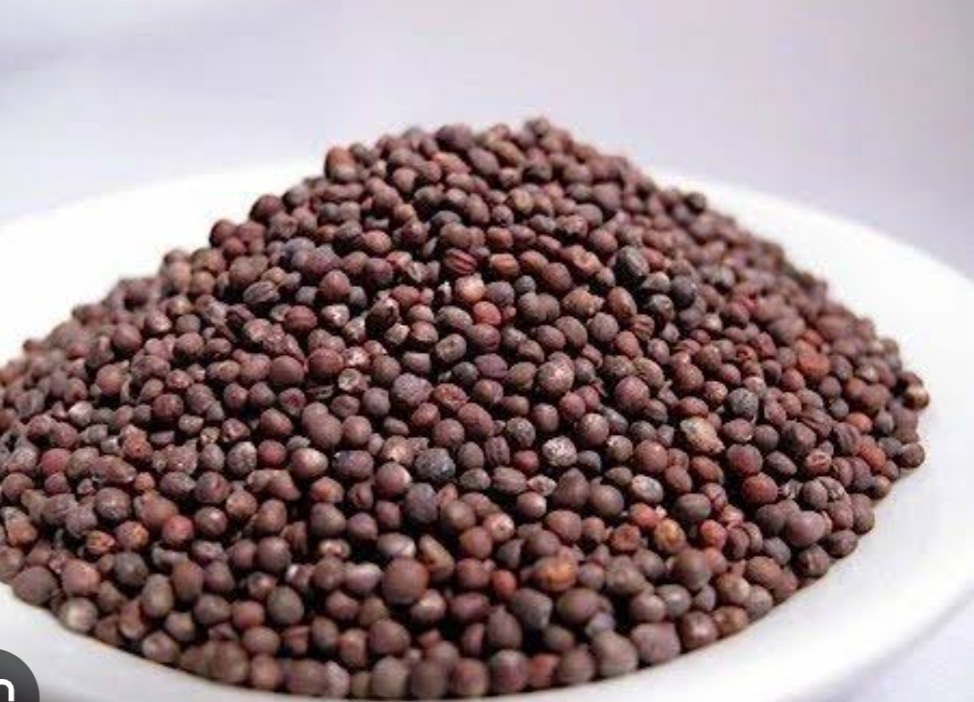
SPACING
Plant spacing is important and depends on the variety and the choice of the farmer based on the market demands. The wider the spacing, the bigger the cabbage that will be harvested and vice versa.
Varieties can be spaced at; 60cm x 60cm for large-headed varieties, 60cm x 45cm for medium sized and 30cm x 30cm for small heads. Also 50cm ×50cm spacing can be used.
An hectare of cabbage farm can produce between 11,000 heads to 12,000 heads.
NURSERY MANAGEMENT
Seedlings can be raised in nursery or plant seeds directly on raised beds in the field.
In the nursery, raised beds can be used to raise seedling. This is recommended for root development and proper drainage. The bed width can be 1 meter and a convenient length not exceeding 100 meters and a height of 15 centimeters is recommended.
In addition to nursery practices, the seeds should be sprayed and treated with:
1. Agrochemicals like trinity Gold (452WP) to control soil borne diseases such Damping off.
2. Pesticides like loyalty( 700 WDG) to control soil borne pests. And
3. Optimizer 20ml/20L to break seed dormancy and ensure uniform growth
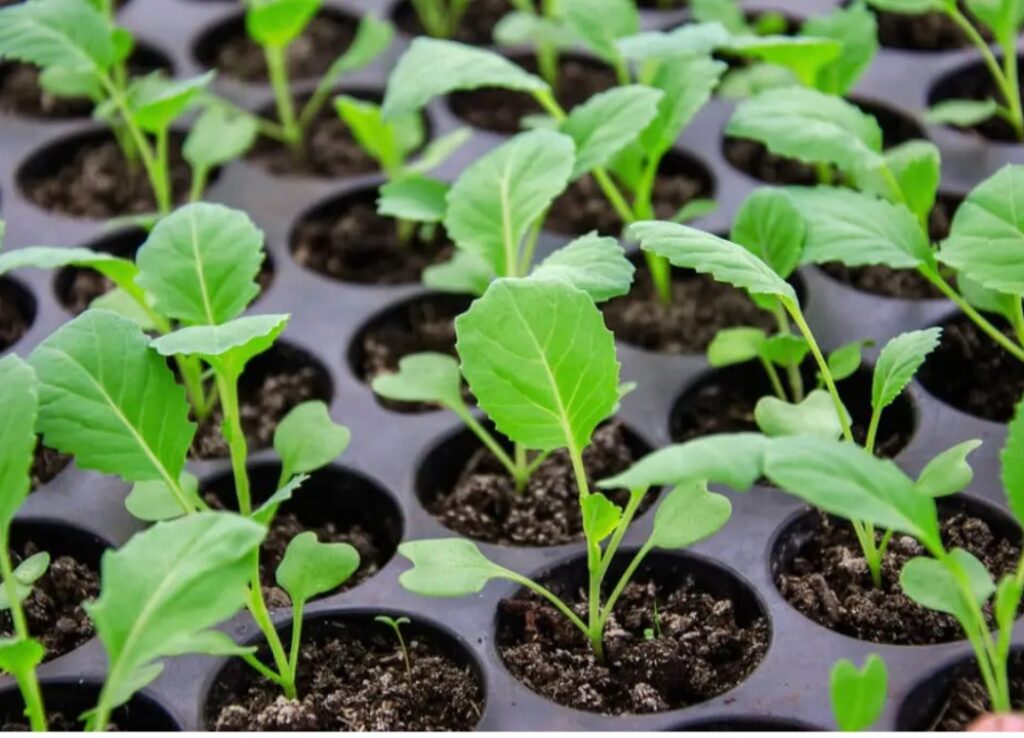
TRANSPLANTING
Seedlings will be ready for transplanting after 4-6 weeks in the nursery, depending on temperatures. Seedlings should be irrigated to keep it wet an hour before transplanting. Seedlings should be planted to the same depth as in the nursery 15cm. After transplanting, the soil should be drenched using Optimizer. Use Optimizer 10ml/20L to relieve transplanting shock and also to enhance the establishment of the veges. This will also help kill cutworms that can destroy the sea drinks.
FERTILIZATION
The amount of fertilizers to be applied will depend on the soil analysis report and soil type. During early stages a lot of Phosphorus is needed to help in root establishment which will be supplied by foliar feeding. During vegetative stage a lot of Nitrogen is needed and this is achieved through foliar feeding. During head formation potassium is needed to ensure proper head formation. These will help determine which nutrient is needed at the different stages of development.
WEED MANAGEMENT
Optimal production of these Brassica leafy vegetables depends on successful weed control. Weeds reduce yields by direct competition for nutrients, water, and light.
It is important to control weeds early in the season because, weed competition can substantially reduce vigor, uniformity, and overall yield.
Pre-emergence herbicide 2-3 days before transplanting can be sprayed to control weeds.
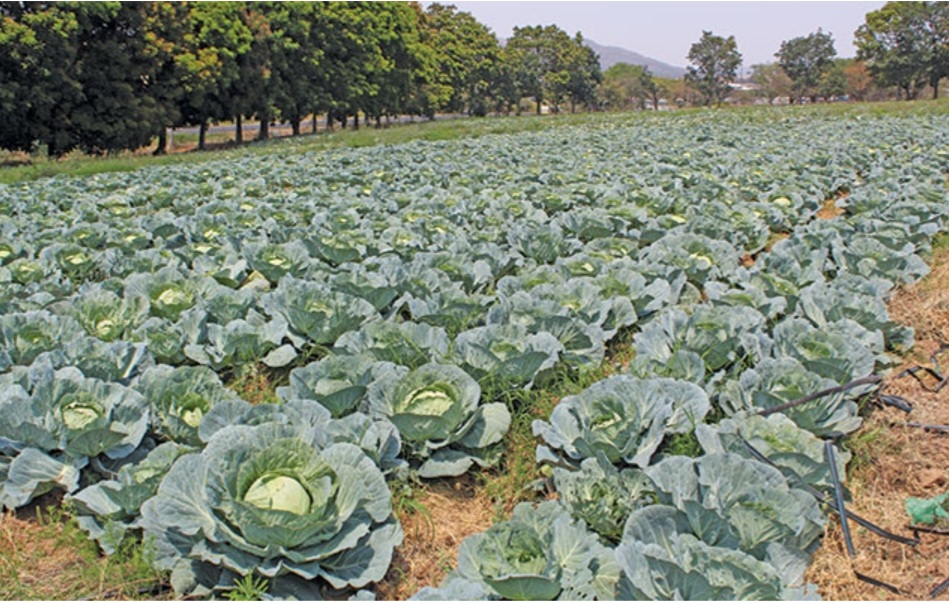
HARVESTING
Cabbage can be harvested any time after the heads form. For highest yield, cut the cabbage heads when they are solid (firm to hand pressure) but before they crack or split. When heads are mature, a sudden heavy rain may cause heads to crack or split wide open. The exposed internal tissue soon becomes unusable.
PEST AND DISEASE MANAGEMENT
Cabbage is a host to several pests and diseases.
PEST MANAGEMENT
Some of the pests that attack cabbage include : diamond back month (DBM), aphids and cabbage saw fly etc.
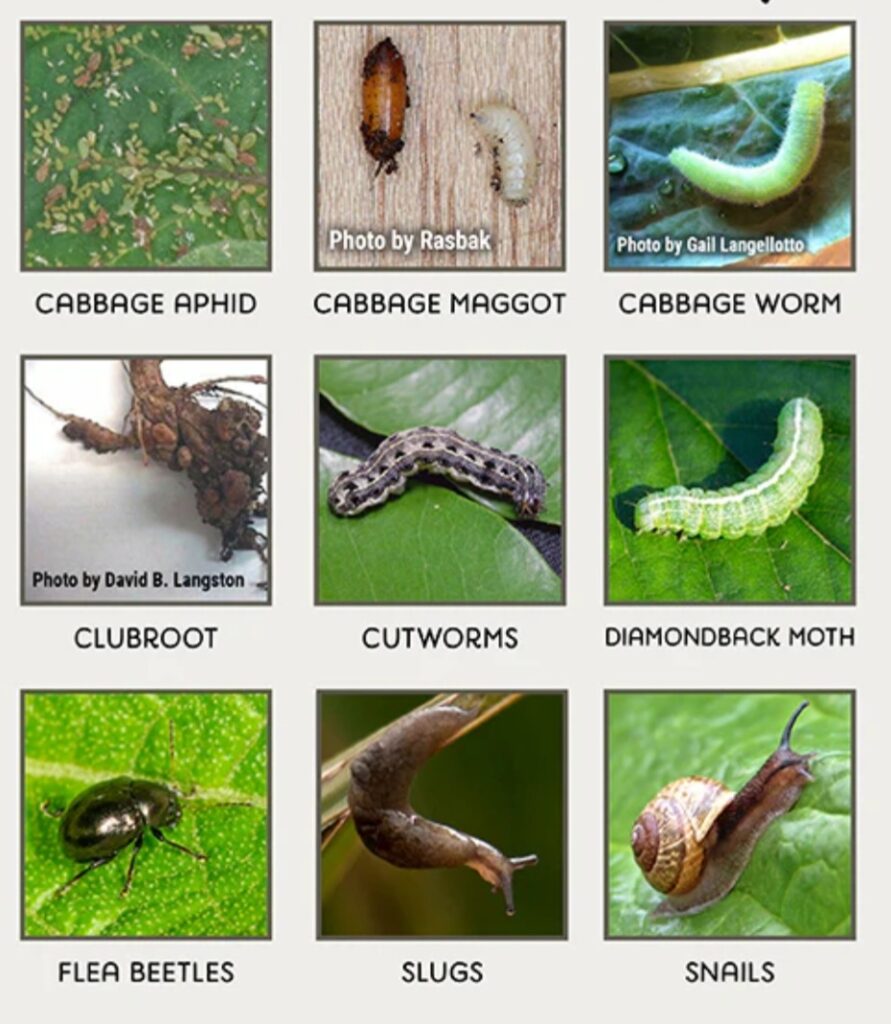
1. DIAMONDBACK MOTH (Plutella xylostella): The larvae emerge from their mines at the conclusion of the first instar, molt beneath the leaf, and thereafter feed on the lower surface of the leaves.
CONTROL: Spray insecticides,
2. CABBAGE LEAF SAWFLY (Athalia rosae): Sawflies are sporadic but serious pests of brassicas. They are black/green caterpillars with a black head.
CONTROL: Spray insecticides like Escort mixed with Integra, plant trap crops and plant mints around the farm.
3. CABBAGE APHID (Brevicoryne brassicae): Aphids feed by sucking sap from their host plants. Continued feeding by aphids causes yellowing, wilting and stunting of plants.
CONTROL; Spray insecticides like Lexus mixed with Integra.
4. CUTWORMS : Cutworms are recognized by their smooth skin, greasy gray colour and “C-shaped”; posture when disturbed. Eggs are laid by the night flying moths on grasses, weeds, and other host plants. Cutworms feed at night causing serious damage to stems and foliage of young plants, during the day they retreat to their underground burrows.
CONTROL: Spray insecticides like Pentagon, plant trap crops, plant mints around the farm.
DISEASE MANAGEMENT
Diseases that attack cabbage include black rot, fungal spots, blight, powdery mildew and bacterial soft rot etc.
1. BLACK ROTS (Xanthomonas campenstris): The disease is easily recognized by the presence of large yellow to yellow-orange “V”-shaped areas extending inward from the margin of older leaves, and by black veins in the infected area. The tap root may rot or turn brown with bad odour.
CONTROL, PREVENTION AND TREATMENT:
a. Spray copper fungicides from the 50th day after planting.
b. Use hot water treatment to destroy the bacteria that may be infesting the seeds.
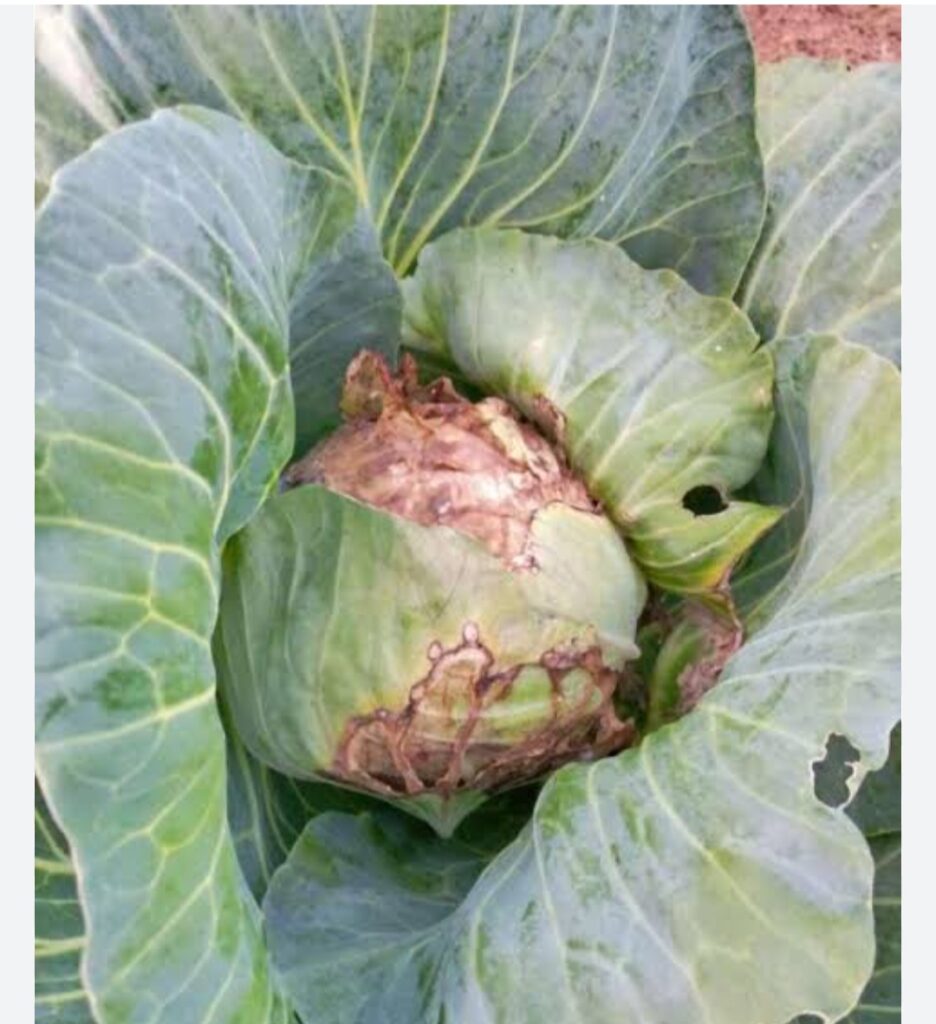
2. DOWNEY MILDEW: This is caused by Hyaloperonospora parasitica previously known as Peronospora parasitica.
Downy mildew is first seen as a fluffy or powdery-white mass of spores on the undersurface of brassica leaves. This is followed by a black speckling and puckering of the upper surface. Leaves prematurely turns yellow and fall from the plants.
CONTROL, PREVENTION AND TREATMENT:
a. Avoid overcrowding seedlings so that there is sufficient air movement around them.
b. Carefully check each seedling before transplanting in the field, and remove any that show downy mildew symptoms.
c. If symptoms are seen, spray all the seedlings with a systemic fungicide like trinity Gold mixed with Integra.
d. Spray full strength vinegar to eliminate heavy accumulations of mildew.
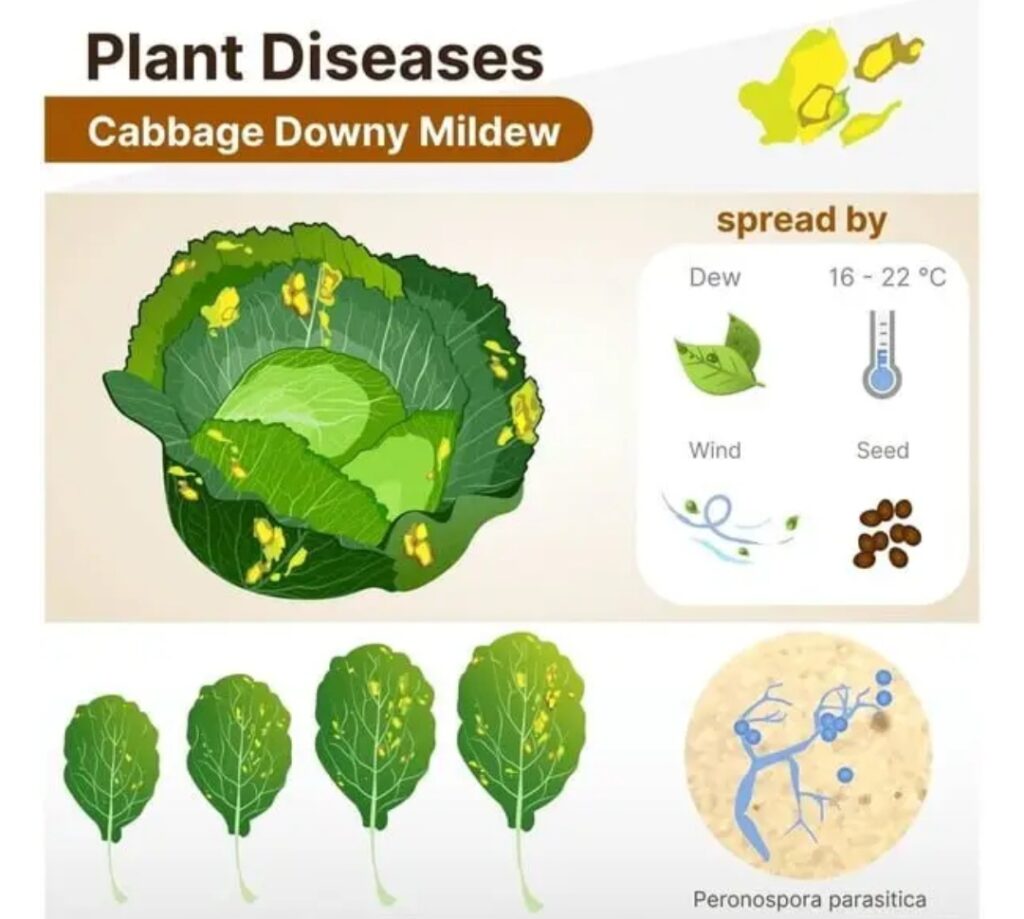
3. DAMPING OFF: Seeds may be infected as soon as moisture penetrates the seed coat or a bit later as the radicle begins to extend, all of which rot immediately under the soil surface (pre-emergence damping-off). Infection results in lesions at or below the soil line. The seedling will discolor or wilt suddenly, or simply collapse and die.
CONTROL, PREVENTION AND TREATMENT:
a. Use certified seeds.
b. Crop rotation for 3 years with maize, onions, spinach, sweet potatoes and beans. The seedbeds should be situated in areas that have not had previous cruciferous crops.
c. Plant on raised beds to reduce moisture content in the root zone and provide appropriate drainage.
d. Avoid field operations when it’s wet.
e .Keep nursery/field weed free.
f. Use clean plastic or wooden trays to raise seedlings.
g. Use a low seed rate in seed beds as overcrowding of seedlings favours the disease.
h. Discard all seedlings with wire stem, and discoloured roots when transplanting and plants with bottom rots, head rots and root rots.
i. Solarise seed bed soil for 8 weeks using transparent plastic paper.
j. Drench with Trichoderma based products eg Trianum at 1:5 (trianum to water), Rootguard, Trichotech, Ecot. or use Propamocarb hydrochloride based products eg Previcur at 30-50ml/20L, Propeller at 60-120ml/20L at seedling stage and twice when crop matures etc.
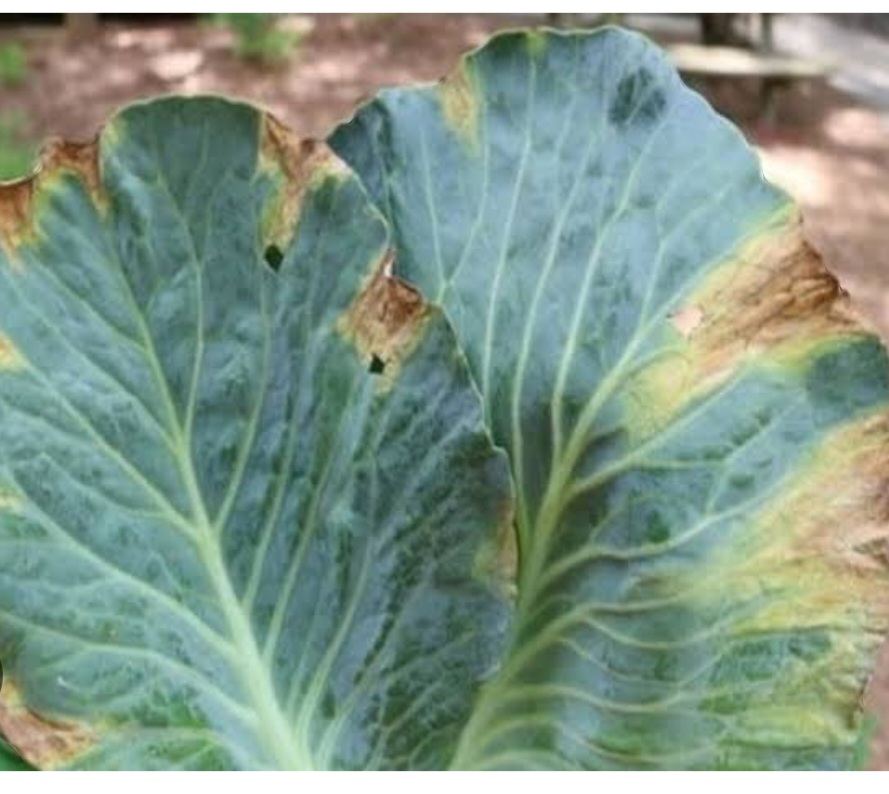
4. HEAD ROT: It is caused by Sclerotinia sclerotiorum.
Symptoms often first appear as water soaked spots on lower or upper cabbage leaves. As water soaked spots enlarge, infected tissue becomes soft, and some outer leaves begin to wilt. A white cottony growth becomes evident on the leaves as the disease progresses.
CONTROL , PREVENTION AND TREATMENT
a. Use of fungicide nativo (tebuconazole mixed with trifloxystrobin) is the most effective. It inhibite growth of the pathogen. Also, carbendazim and tebuconazole can be used.
b. Use of biocontrol agents like Trichoderma viride TV-1 .
5. ALTERNARIA LEAF SPOT:
Alternaria Leaf Spot is a common disease of cabbage caused by the fungal pathogen Alternaria brassicicola.
The most common symptom of Alternaria diseases is yellow, dark brown to black circular leaf spots with target like, concentric rings. Lesion centers may fall out, giving the leaf spots a shot-hole appearance. Individual spots coalesce into large necrotic areas and leaf drop can occur.
CONTROL , PREVENTION AND TREATMENT
a. Use clean seed and practice crop rotation.
b. Apply fungicides as foliar sprays .
